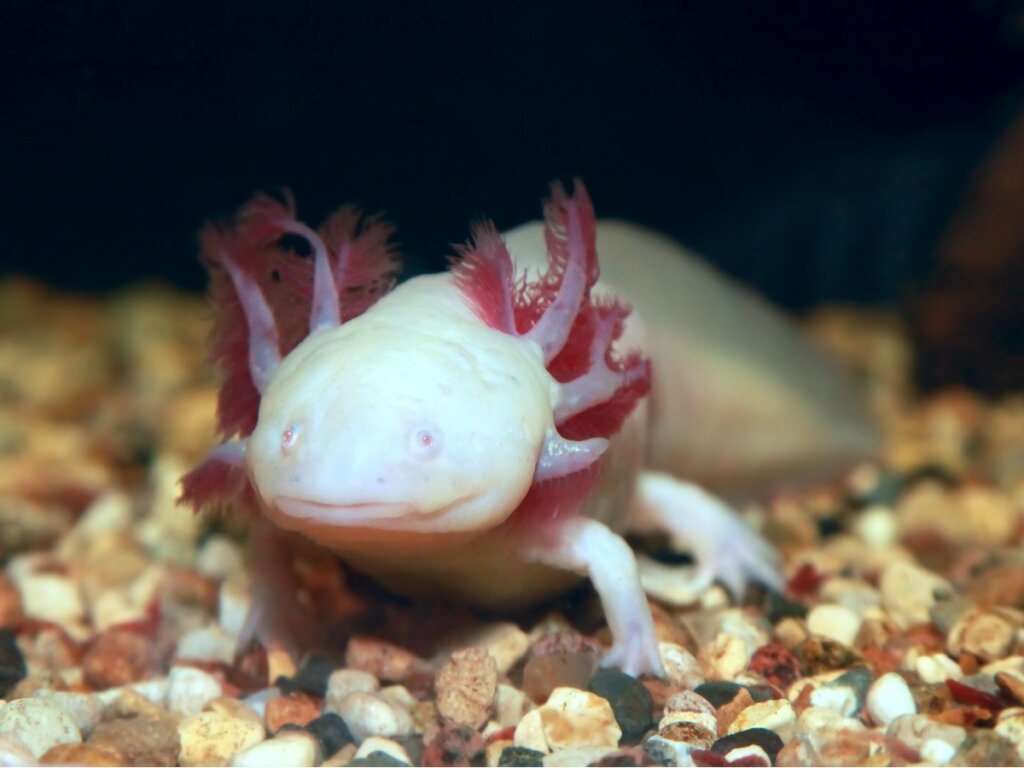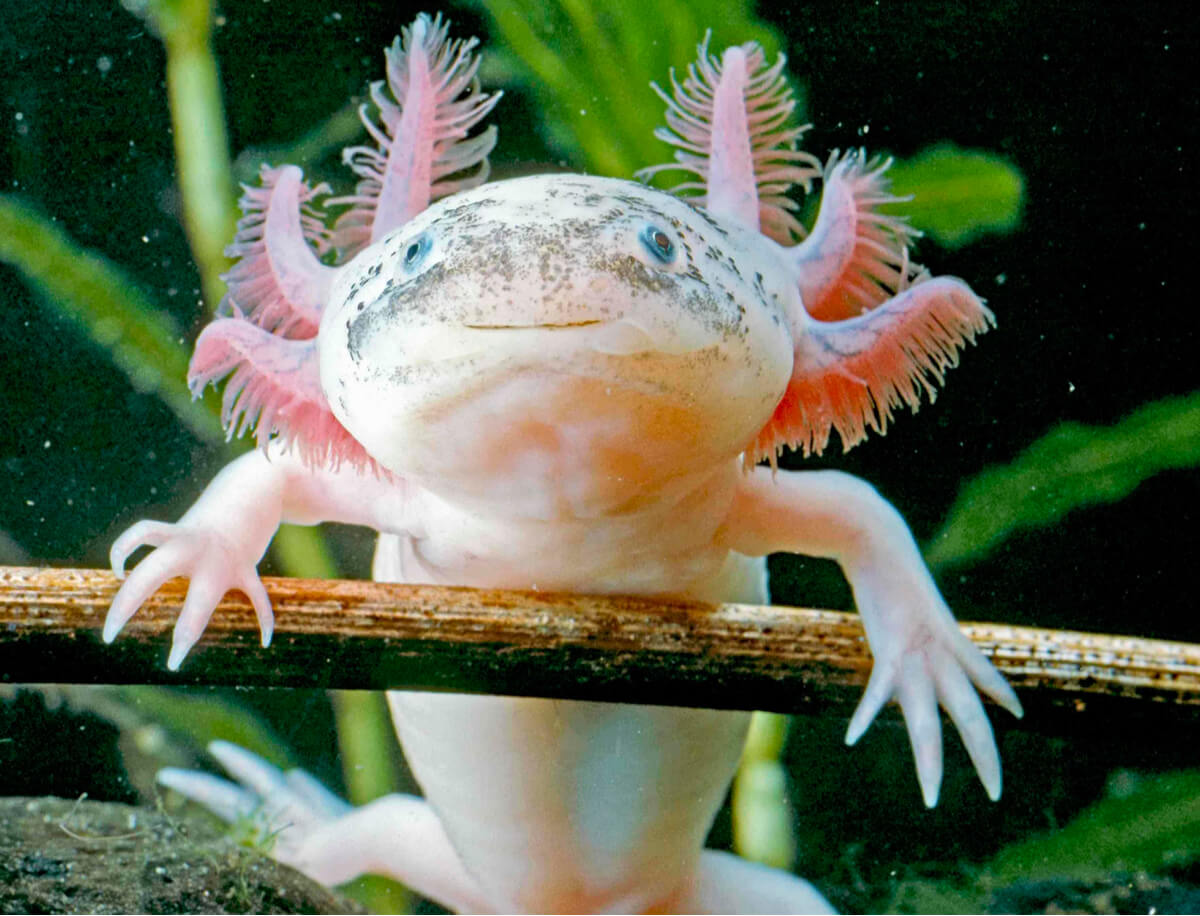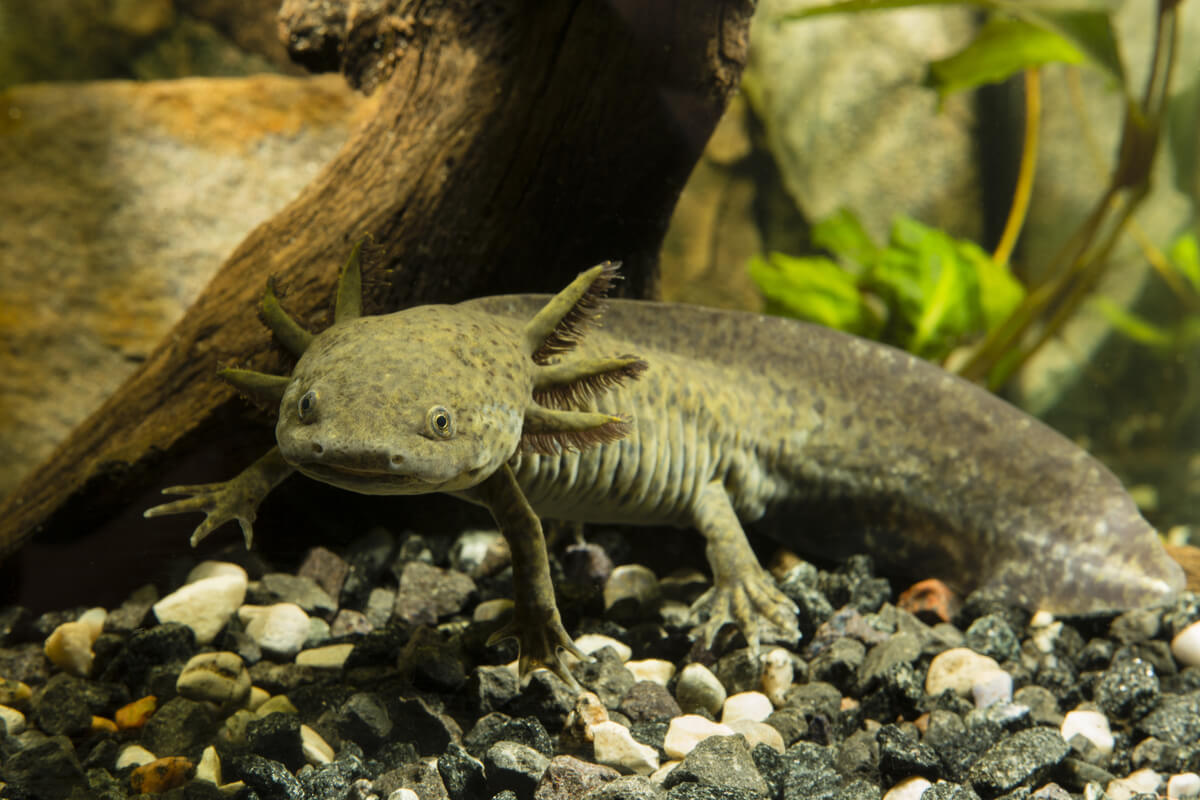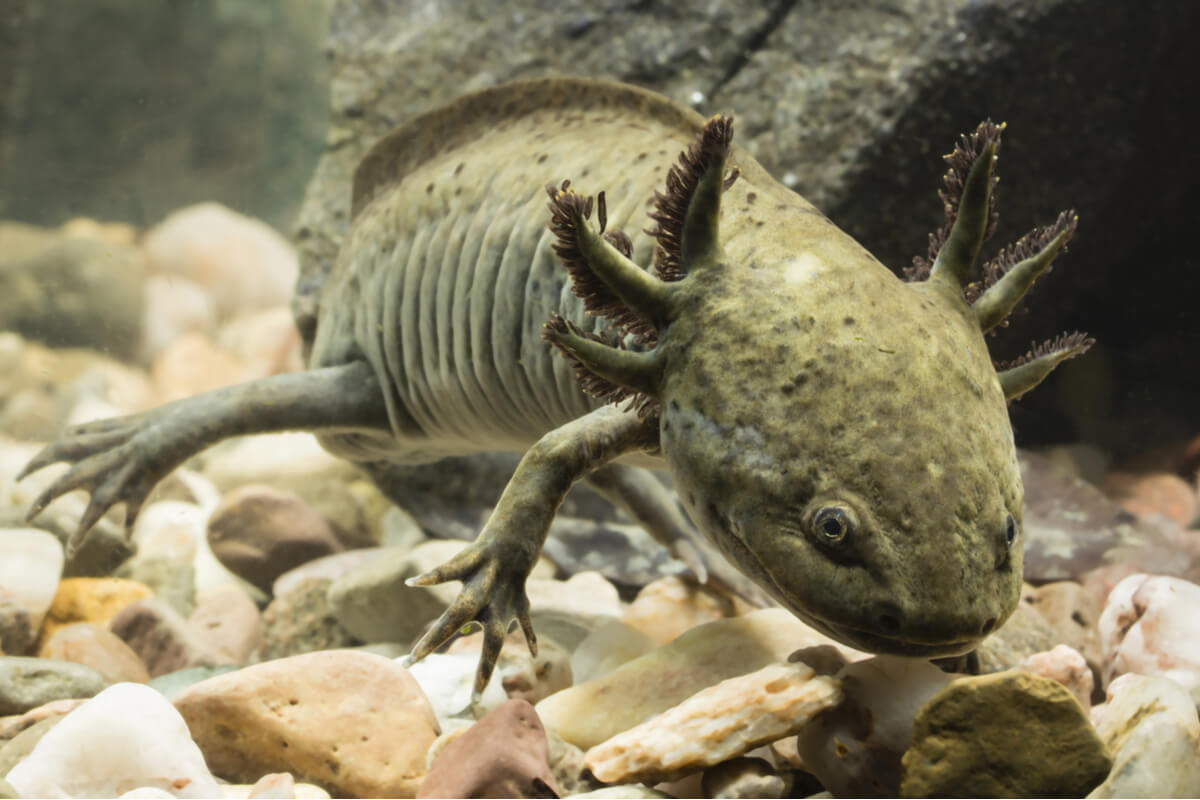10 Curious Facts About the Axolotl

The axolotl (Ambystoma mexicanum) is one of the most famous amphibians in the world. It can be found in the homes of many exotic animal lovers, as it has a fascinating appearance and is simple to care for. However, most people don’t realize that it’s just one step away from extinction.
In recent decades, the natural axolotl population has shrunk by 60. For this reason, it’s now in a critically endangered status, as indicated by the Red List of the International Union for Conservation of Nature (IUCN). If you want to know 10 curious facts about the axolotl, an animal as beautiful as it is threatened, keep reading.
1. The axolotl doesn’t metamorphose like the rest of amphibians
Amphibians are famous for undergoing a process known as metamorphosis , especially striking in frogs and toads. Anurans are born as larvae (tadpoles) with tails, gills, and no legs or lungs, but they end up developing the body of an adult when they partially leave the aquatic environment.
The axolotl is the exception here, as it remains in constant neoteny, that is, it never completely metamorphoses. Axolotls maintain their larval state throughout their lives due to a lack of thyroid-stimulating hormone (TSH), a vital compound in the normal development of amphibians.
For this reason, axolotls retain larval characters from hatch to death. This is exemplified, above all, by the presence of cephalic gills.

2. Metamorphosis can be induced in an axolotl
The axolotl is neotenic and pedomorphic — it maintains youthful features — but this only applies in nature. According to the scientific portal Animal Diversity, in the laboratory the metamorphosis of this species can be induced by thyroid hormone injections. This causes gill resorption and other notable morphological changes.
3. Its natural color isn’t white
We’re used to observing axolotls in aquariums and fish tanks, and therefore, it’s easy to think that they’re white. Nothing could be further from the truth, as the real color of these amphibians is brown.
As studies from the Science Direct portal indicate, four different genes encode the coloring of the axolotl. Due to the selective crossing of mutations in captivity, the following tones can be recorded in domestic specimens:
- Leucistic: Pale in color, but with black eyes.
- Albino: Pale in color with red eyes.
- Golden albino: Very similar to the albino variant, but with a yellowish hue on the white background.
- Xanthic: Gray with black eyes.
- Melanoid: Completely black.
- Wild: The coloration that truly characterizes the species.
Among the curiosities of the axolotl, its ability to acquire different colors according to genetic mutations stands out.

4. An amphibian that hunts by suction
In general, amphibians have long, sticky tongues, which they launch like a projectile to catch the flying insects they feed on. This preconception is almost never fulfilled in the wild.
For example, axolotls feed by means of a suction mechanism. Thanks to their complex cranial morphology, these amphibians are capable of opening their mouths very quickly. They drag the surrounding water into their oral cavity by force and are helped by pressure differences. This urodele is capable of ingesting its prey whole.
5. It’s capable of regeneration
When a human being is seriously injured, a scar appears where the injury is. This is made up of scar tissue, a fibrous conglomerate that serves to partially but not completely solve the problem. When an organ is scarred, part of its functionality is lost.
Axolotls are an exciting scientific model, because in the event of injuries they don’t get scars. They’re able to fully regenerate damaged tissue. They can replace a limb in a matter of months and repair more complex structures, such as the tail, some organs, nerve tissues, and parts of the heart and eyes.
This species and other salamanders are believed to regenerate their tissues by modifying their internal macrophage levels and by suppressing inflammatory events.
6. It has a larger genome than humans
Humans have 3.2 billion base pairs in their DNA, while the axolotl has 32 billion. Although its genome is 10 times longer than ours, it encodes a very similar number of proteins (23,251) to the figure reported in the human species. Experts believe its genome is so large because it has so many repeating sequences.
7. Its range of distribution is very limited
The axolotl is only native to the waters of Lake Xochimilco and Lake Chalco (Valley of Mexico). Lake Chalco has been drained to prevent flooding, while Lake Xochimilco has been drastically reduced in terms of water mass and ecosystem viability. As we’ll see, this goes a long way to explaining the current decline in the species.
8. Their care in captivity isn’t as easy as it seems
The axolotl is kept in many fish tanks across the globe, but not all owners know its requirements. For example, it’s very important to note that the water in the aquarium should never exceed 23ºC (73 F) for an extended period, as this increases its metabolic rate, causes stress and ultimately death.
The optimum temperature range for this species is between 18 and 20 ºC (64 – 68 F), although it also copes with 22 ºC without many problems. It’s important to point out that chlorine – added to almost all drinking water – is very dangerous for axolotls. You should only get a pet like this if you have enough experience.
Experts strongly discourage keeping an axolotl with cold-water fish. In all cases, this combination ends in tragedy.
9. An important figure in popular culture
In Aztec legends, the desperate god Axolotl transformed himself into one of these amphibians to avoid being captured and sacrificed by his fellow gods, who sought him out because of his rebellion. This small historical fragment shows us that the axolotl has been part of the history and culture of Mexico for hundreds of years.
Beyond this, Ambystoma mexicanum has also permeated the general culture in every possible medium. Without going any further, the Bojack horseman series gave us an anthropomorphic character based entirely on this animal, dubbed by actress Natale Morales. Since June 2021, it can also be found in the waters of the Minecraft video game.
It’s expected that, by 2022, a 50 Mexican peso coin with this species engraved on it will enter circulation. The axolotl is a truly unique animal.
10. One of the most threatened species in the world
It’s impossible to finish a list of axolotl curiosities on a positive note, as the prognosis of the species is critical. As indicated by professional sources, experts estimate that there are only between 700 and 1200 specimens left in the wild – 60 times less than a few decades ago.
The pollution of the waters, the degradation of its natural environment, and the introduction of non-native fish into its ecosystem are the main threats to this amphibian. To this day, their populations continue to decline – despite all the conservation programs in place.

Here we have given you 10 curious facts about the axolotl, but they aren’t the only ones. We recommend that you find out more about this species and find out about its state of conservation. The first step to preservation is always knowledge.
All cited sources were thoroughly reviewed by our team to ensure their quality, reliability, currency, and validity. The bibliography of this article was considered reliable and of academic or scientific accuracy.
- Frost, S. K., Briggs, F., & Malacinski, G. M. (1984). A color atlas of pigment genes in the Mexican axolotl (Ambystoma mexicanum). Differentiation, 26(1-3), 182-188.
- Schreckenberg, G. M., & Jacobson, A. G. (1975). Normal stages of development of the axolotl, Ambystoma mexicanum. Developmental biology, 42(2), 391-399.
- Smith, J. J., Timoshevskaya, N., Timoshevskiy, V. A., Keinath, M. C., Hardy, D., & Voss, S. R. (2019). A chromosome-scale assembly of the axolotl genome. Genome research, 29(2), 317-324.
- Leigh, N. D., Dunlap, G. S., Johnson, K., Mariano, R., Oshiro, R., Wong, A. Y., … & Whited, J. L. (2018). Transcriptomic landscape of the blastema niche in regenerating adult axolotl limbs at single-cell resolution. Nature communications, 9(1), 1-14.
- Vieira, W. A., Wells, K. M., & McCusker, C. D. (2020). Advancements to the axolotl model for regeneration and aging. Gerontology, 66(3), 212-222.
